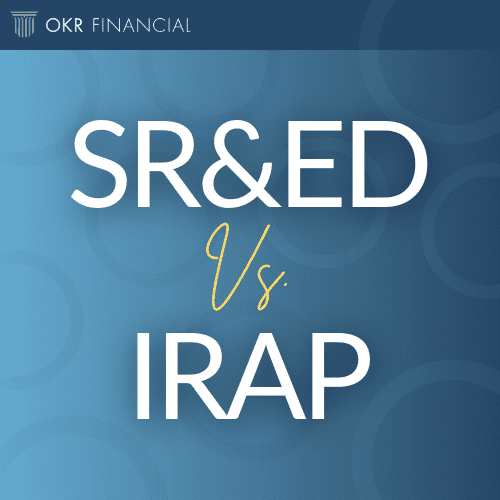Two of the most popular Government incentive programs in Canada is the Scientific Research and Experimental Development (‘SR&ED’) tax credit program and the Industrial Research Assistance Program (‘IRAP’). Both support the growth of Canadian companies and innovation! Even though the programs look similar, they have some key differences.
What is the SR&ED Tax Credit Program?
The SR&ED Program is a tax incentive program that encourages all Canadian businesses to conduct R&D in Canada.
You can utilize it by deducting your R&D expenses from your business income or a refund from the CRA if taxes aren’t owed at year-end. R&D expenses relating to wages, materials consumed, and contractor costs can all be claimed.
An investment tax credit can be received between 15-40% for these project expenses.
This makes the SR&ED Program ideal for corporations with a lot of overhead costs in their R&D projects. SR&ED refund percentages vary from province-to-province, so be sure to look into your province’s reimbursement amounts.
Your company will receive its provincial portion of SR&ED according to the rules of the province that the research is conducted.
How do I become eligible for the SR&ED tax credit program?
The Government of Canada doesn’t list specific tasks to qualify for this program. The basic rule is to work on projects that face scientific or technological uncertainties.
A company must show that they’re conducting systematic research in science and technology through experimentation and analysis. This can include:
- Basic research, where work is being done to advance scientific knowledge without a specific practical application
- Applied research, where work is done to advance scientific knowledge with a specific practical application
- Experimental development work being done with the purpose of advancing technology in order to create new, or improve existing, materials, products, and processes. This can include incremental improvements as well.
How does a company claim SR&ED expenses to get a refund?
The process is pretty simple! When a company files its income tax return, they would also complete Form T661.
This form will require all of the technical writing for the project(s) as well as expenses incurred from the R&D. You can report expenditures no later than 12 months after your corporation’s income tax return is due
What is the IRAP Program?
The IRAP Program is quite similar to SR&ED, as it’s designed to bring about innovation from Canada’s small-to-medium sized enterprises. The program offers companies pre approval for their R&D expenses relating to labour, contractor and capital expenditure costs used for R&D purposes.
Whereas SR&ED offers a reimbursement between 15-40% on overall expenses, IRAP can provide contributions up to 80% of labour and contractor expenses. If your company is labour intensive on its R&D, then IRAP is the optimal program to apply for.
How do I become eligible for the IRAP program?
There are a few defining features to be considered for IRAP funding. You corporation must be a profit oriented, Canadian SME with 500 or less full-time employees.
To facilitate innovation within Canada, your company must have the goal of growing and generating profits with new or improved technology and products.
Unlike SR&ED where you receive funding for work that has already been done, IRAP requires project approval before beginning the project.
How to apply to the IRAP program?
To begin applying for the IRAP Program, you should reach out to your local IRAP industrial technology advisor.
Your advisor will be able to offer you some insight for you proposed project. They can provide your business with technical and business advice, referrals to other programs and services, and will be able to connect you with other experts.
The technology advisor will also be the one to assess your project’s overview and technology, and they’ll look into your business’ market and economic impact. If they find your project to be eligible, they’ll help you submit a funding proposal.
After your funding proposal has been approved, your company will receive a contribution agreement that will outline your projects funding, timeline, and milestones with reporting guidelines.
Now a project can be started, and funding will usually be released in tranches regularly as project costs are incurred.
How to utilize both SR&ED and IRAP?
It’s important to know that SR&ED and IRAP cannot be stacked together, but they can be used simultaneously.
A great way to use these programs collectively is to have one large project that utilizes IRAP reimbursements, and sub-projects within this that have technological uncertainties that SR&ED can financially assist with.
If IRAP reimburses a company $60 for every $100 spent on R&D labour, the company can claim the remaining $40 as a SR&ED expense if the project is eligible.
Being able to take advantage of these great programs can help businesses take bigger strides in their growth. Be sure to look into these programs to give your company further opportunities. More information on SR&ED and IRAP can be found here and here.
Disclaimer: Any views or opinions are not intended to malign any religion, ethnic group, club, organization, company, or individual. All content provided on this blog is for informational purposes only.







